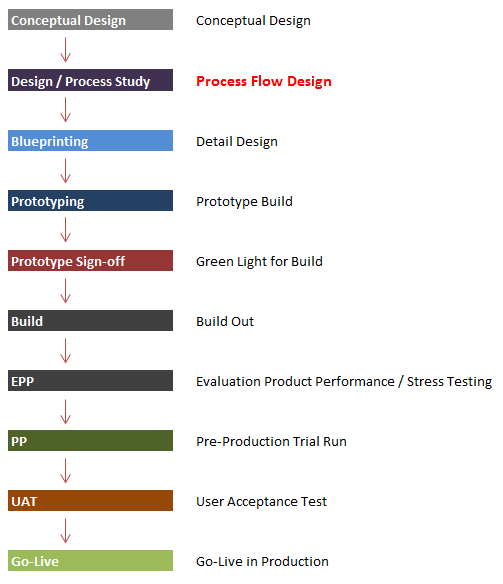How to Get the Most from Business Process Flows in SAP BPC
Overview
The Process Flow Design is an integral part of any SAP BPC implementation project. As a stage in the project it should come immediately after the Conceptual Design phase and before the essential Blueprinting step, as shown in the diagram, below which outlines the ten basic project stages.

So why is the Process Flow Design such an early and important part of the project? Consider that designing your processes is the same as defining:
- What tasks need to be carried out for Who has authorisation?
- Data input?
- Import and transformation of transactional data from external data sources?
- Update of master data?
- Legal consolidation including automatic eliminations and journals?
- When can the task be carried out?
- Who needs to review the outcomes?
So carrying out the Process Design Study is essential before the Blueprinting stage, as the results of the study will provide input to the detailed Blueprinting step.
On the other hand, badly designed or missing processes in the Production environment mean:
- Confusion about who does which step when.
- Transactional data uploads failing or producing invalid results.
- Validations not being performed.
- Transformations not updated.
- Incomplete consolidations.
This in turn will mean that rework is required and that “fast closes” are not fast due to missing or incorrect data.
In some complex environments there are many steps to execute with data being input from multiple sites for consolidation and where there are uploads from multiple data sources with transformations. The lack of clarity if the process flows are not well defined in these cases can lead to a great deal of confusion which can put severe stress on the BPC implementation and can even cause it to fail.
Business Process Flows in SAP BPC
SAP BPC provides an integrated Business Process Flow functionality, which allows for each task in the process flow to be assigned to a user (or a team) and to be validated by a manager. This means that each process can be included in a work flow where managers have visibility on tasks and validations carried out.
In order to provide examples of how Business Process Flows should be implemented in SAP BPC, three main areas have been identified. At each step, Business Process Flows should be configured to ensure that there is a user or a team assigned to carry out the task and a manager assigned to validate and close it so that the next stage can be started.
- Master Data Management
- BPC master data must be in line with source master data or uploads will fail.
- Identify the user or team responsible.
- Source Data Administration team. Responsibility may be pushed down to the team in charge of preparing the data in the source database.
- BPC Administration team. An option is to centralize responsibility for all updates of the SAP BPC system with the Administration team.
- Marketing Dept. Where new products need to be added to the master data it may be that responsibility should be devolved to the Marketing or Product Development teams. Another common case is to have to plan for products and other elements that are not being reported as actual data, and so are not in the source master data, and in this case the Marketing Department would be the natural owner.
- Controlling team. Where new management accounts need to be added to the master data, it maybe that responsibility should be devolved to the Controlling Team.
- Accounting team. Where SAP BPC is primarily a financial reporting system, in the case of actual data, an option is to devolve responsibility to the Accounting Team for updates of financial accounts or for all master data updates.
- Source System Transactional Data Updates Process Flow
- SAP BPC master data must be in line with source system transactional data or uploads will fail
- For each step in the upload process a user or team must be given ownership
- Extract. Extraction of source system transactional data may be the responsibility of the team in charge of preparing the data in the source database or the SAP BPC Admin team.
- Transform. Generally logics will need to be run to transform the data into SAP BPC format. This task is normally carried out by the SAP BPC Admin team.
- Load. Loading the transformed data to the SAP BPC database is a task is normally carried out by the SAP BPC Admin team. If there are issues on upload because of missing or erroneous records in the Masterdata or transactional data, the responsibility for remediation is passed to the owner of the Masterdata or transactional data.
- Consolidate. The SAP BPC Admin team will generally launch the consolidation process steps, although the final owner of the process will be the Accounting team. SAP BPC has integrated Consolidation Controls, which serve as blocking or warning validations for the consolidation process.
- Validate. After upload and consolidation, data should be signed off by the Accounting team.
- Input Data Process Flows
- In this case, multiple users may be inputting data
- Each user’s data input needs to be signed off by the Process Flow owner of that data set
- Period unlocking. Data input is controlled by locking and unlocking time periods, categories, and companies/cost centres. This is controlled by either the owner of the data set being input, or by the SAP BPC Admin team.
- Data input by multiple authorised users. Security settings are set up by the SAP BPC Admin team.
- Validation and approval. The owner of the data set validates and approves the data input and changes the status of the step in the Business Process Flow.
- Period closing. This will happen automatically when the status of the step is changed by the owner after validation and approval. The period may be left open for the manager or owner of the data set to make adjustments.
Points to Take Away
- Define your process, step by step
- Assign an owner and a manager to each step
- Formalise the process with SAP BPC Business Process Flows
Want to learn more valuable information from Column5 experts? Check out Column5EPMEvents.com!
Related Blogs











